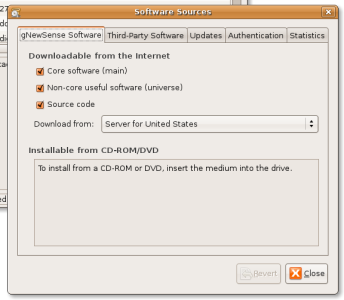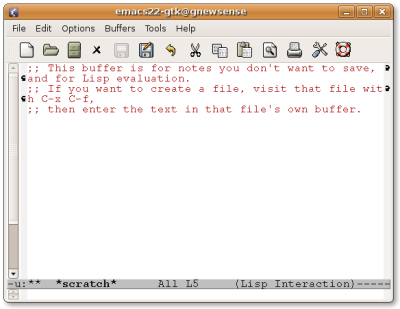Author: Kurt Edelbrock
Free software lovers can rejoice at this month’s release of gNewSense 2.0 (pronounced “guh-new-sense”), the latest version of the popular distribution based on Ubuntu Hardy Heron. Code-named DeltaH, this operating system includes only software where users have the right to run, study, adapt, redistribute, and improve all of the software and code. To that end, gNewSense is supported and sponsored by the Free Software Foundation (FSF). The strict freedom-ware requirement excludes a great deal of software, including proprietary drivers for wireless and video cards, leaving most users with a less functional — albeit less tainted — derivative of Ubuntu 8.04.
gNewSense is a great alternative to Gobuntu, the Canonical-sponsored free derivative of Ubuntu. According to its wiki page, the 8.04 version of Gobuntu hasn’t been released due to a less-than-optimal reaction from the community. Gobuntu used the same repositories as Ubuntu, and the Ubuntu live CD can achieve the same installation as Gobuntu by merely selecting the free-software-only option in the installer (press F6 twice at the boot menu). Also, Mark Shuttleworth, the founder of Ubuntu, has indicated that he would rather focus on gNewSense because the work on that distribution can help the Ubuntu community as a whole.
Ubuntu minus non-free software
gNewSense removes more than 100 pieces of proprietary code and firmware from the Ubuntu kernel, including support for ATI and Nvidia graphics chipsets and wireless networking drivers. In the current version, the non-free GLX OpenGL extensions for X were removed from the standard X window server. Firefox has been replaced with Epiphany to avoid issues revolving around Mozilla trademark claims. Epiphany is a good fit, as it is based on the GNOME libraries and integrates well into the desktop.
The distribution is based on precompiled packages, much like Ubuntu, and provides its own repositories for installing and updating software. Ubuntu’s proprietary Restricted software repository is not included and can’t be easily added, as it can in Gobuntu. The gNewSense Universe repository, which includes software that isn’t part of the core system, is enabled by default. All of the non-free documentation and artwork included with Ubuntu is removed, though the wallpaper and icons in the DeltaH version have been redone to beautify the desktop a little bit. The latest version also includes support for Debian source packages.
Most users will choose to install gNewSense from the live CD. When users are ready to partition their disk and install the distribution their hard drives, they can do so using the Ubiquity installer from the live environment.
All of the applications you’ll find in Ubuntu are also included in gNewSense, with the exception of Firefox. The build-essential packages and gcc — which provide support for compiling software from source — are included, as well as the text-editor Emacs, and applications such as OpenOffice.org, Pidgin, and the GIMP. Users get a full set of desktop applications along with some built-in support for developing and installing applications from source.

With the Builder script included with gNewSense, you can create your own Linux distribution using entirely free software. This is perfect for people who don’t want to add or distribute software with restricted or limited-usage licenses. It’s easy to use: distro developers only need to put basic information, such as the distribution name and a list of included packages, into a configuration file, and the script will create the repository and the CD images for you. The only downside is that it requires downloading about 40GB worth of packages, so a fast Internet connection is strongly recommended. This approach could be better than using something like AptOnCD for giving your distribution to friends or using it as a rescue backup.
Why bother with gNewSense?
So why would someone want to install a less robust Ubuntu clone that most likely won’t work with some widely used hardware? To be perfectly honest, most users won’t want to use gNewSense on a daily basis, if at all. Yet, there are some benefits for developers. Putting the ideological benefits of free software aside (though they can be quite persuasive), gNewSense is the perfect distribution for developers to use to test their hardware for free software compatibility. There’s a substantial benefit for hardware manufacturers to provide Linux support out of the box without the installation of special kernel modules or proprietary drivers, and using gNewSense is a great way to do it. Also, gNewSense can function as a “model example” for other software and distribution maintainers. Because it consistently sacrifices ease and usability for compliance, it gives the world a true picture of what a free operating system looks like. It is the actualization of an ideal that has been previously hard to operationalize. The FSF can reap benefits from the existence of gNewSense as well: for one thing, it now has a distribution it can wholeheartedly recommend, sponsor, and endorse.
The most persuasive argument for gNewSense is somewhat of a paradox, because it relies on the distribution’s weaknesses. Every problem, bug, and issue stemming from the single-minded use of free software is a vivid suggestion to developers about areas they should focus on. This work — the discovery of problem packages and the creation of viable free software solutions — is central to the logic alluded to by Shuttleworth. By discovering the issues with software support and fixing them through both encouraging hardware vendors for fixes and developing better free firmware and drivers, developers are creating a benefit for the entire community.
gNewSense may be a nuisance to use, but it might just be a key factor in the evolution of Linux.
Categories:
- Reviews
- Linux
- Distributions



